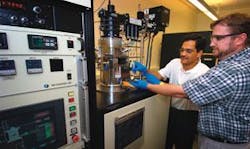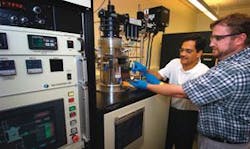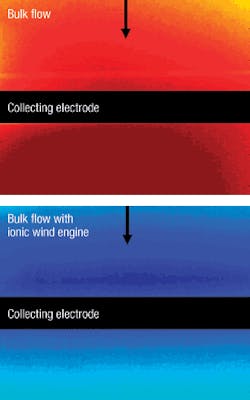By John McHale
WEST LAFAYETTE, Ind. - Military designers continue to fight the challenge of thermal management as today’s microprocessors generate ever-more heat on boards, typically through convection, conduction, or liquid cooling techniques.
Yet researchers at Purdue University in West Lafayette, Ind., are taking a new approach with a new technology that uses tiny “ionic wind engines” that they say might dramatically improve computer chip cooling-a constant challenge for military and commercial electronics designers.
The researchers, in work funded by Intel Corp., have shown that the technology increased the “heat-transfer coefficient,” which describes the cooling rate, by as much as 250 percent.
“Other experimental cooling-enhancement approaches might give you a 40 percent or a 50 percent improvement,” says Suresh Garimella, a professor of mechanical engineering at Purdue. “A 250 percent improvement is quite unusual.”
When used in combination with a conventional fan, the experimental device enhanced the fan’s effectiveness by increasing airflow to the surface of a mock computer chip.
Findings are detailed in a research paper that has been accepted for publication in the Journal of Applied Physics and was tentatively scheduled to appear in the Sept. 1 issue. The paper was authored by mechanical engineering doctoral student David Go, Garimella, associate professor of mechanical engineering Timothy Fisher and Intel research engineer Rajiv Mongia.
The new cooling technology could be introduced in computers within three years if researchers are able to miniaturize it and make the system rugged enough, Garimella says. As the technology is further developed, such cooling devices might be integrated into portable consumer electronics products, including cell phones.
Advanced cooling technologies are needed to help industry meet the conflicting goals of developing more compact and lightweight computers that are still powerful enough to run high-intensity programs. “In computers and electronics, power equals heat, so we need to find ways to manage the heat generated in more powerful laptops and handheld computers,” Fisher says.
The experimental cooling device, which was fabricated on top of a mock computer chip, works by generating ions-or electrically charged atoms-using electrodes placed near one another. The device contained a positively charged wire, or anode, and negatively charged electrodes, called cathodes.
The anode was positioned about 10 millimeters above the cathodes. When voltage was passed through the device, the negatively charged electrodes discharged electrons toward the positively charged anode. Along the way, the electrons collided with air molecules, producing positively charged ions, which were then attracted back toward the negatively charged electrodes, creating an “ionic wind.”
This breeze increased the airflow on the surface of the experimental chip.
Conventional cooling technologies are limited by a principle called the “no-slip” effect-as air flows over an object, the air molecules nearest the surface remain stationary. The molecules farther away from the surface move progressively faster. This phenomenon hinders computer cooling because it restricts airflow where it is most needed, directly on the chip’s hot surface.
The new approach potentially solves this problem by using the ionic wind effect in combination with a conventional fan to create airflow immediately adjacent to the chip’s surface, Fisher says.
The device was created at Purdue’s Birck Nanotechnology Center in the university’s Discovery Park. The researchers quantified the cooling effect with infrared imaging, which showed the technology reduced heating from about 60 degrees Celsius-or 140 degrees Fahrenheit-to about 35 degrees C, or 95 F.
“We’ve been trying to make this work for about a year, and now we have shown that it works quite well,” Garimella says. Patents are pending for the new design.
The researchers also have developed computational models to track the flow of electrons and ions generated by the device, information needed for designing future systems using the technology.
The next step in the research will be to reduce the size of components within the device from the scale of millimeters to microns, or millionths of a meter. Miniaturizing the technology will be critical to applying the method to computers and consumer electronics, allowing the device to operate at lower voltage and to cool small hot spots, Garimella says.
Another challenge will be making the technology more rugged. “As things get smaller, they get more delicate, so we need to strengthen all the elements. We believe we can achieve this goal in a year or so,” Garimella says.
Earlier work at Purdue to develop the ionic-wind technique has been supported by the National Science Foundation. Raul Maturana, an undergraduate mechanical engineering student was also involved in the research.





